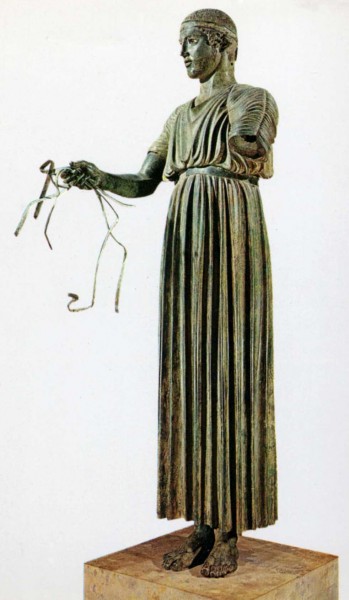Wagenlenker von Delphi

Die Gruppe des Wagenlenkers wurde laut Weihinschrift von dem Tyrannenherrscher Polyzalos in Sizilien um 475 vor Christus in Auftrag gegeben. Vermutlich setzte sich Polyzalos mit der idealisierten Figur ein Denkmal, da er selbst begeistert Wagenrennen fuhr. Entschlossen dreinblickend hat er den Mund leicht geöffnet. Eine Binde mit Mäanderband umschließt das Haupt. Das Original befindet sich in Delphi. Ein separater Abguss des Kopfes ist unter der Formnummer R-00355-A erhältlich.
Replica
| Material: | Plaster cast |
| Collection Area: | Antiquity |
| Object Type: | Sculpture |
| Dimensions: | Height: 195 cm |
| Weight: | ca. 90 kg |
| Historic Mould | |
| Mould acquisition: | 1942 |
Original
| Material: | Bronze mit farblichen Einlagen |
| Artist: | Unbekannter Künstler |
| Epoch: | Ca. 478-474 BC |
| Origin: | Greek |
| Place where found: | Delphi |
| Location: | Delphi, Archaeological Museum |
| Inventory no.: | 3484, 3520, 3540 |
Notes on information
Historical Mould
The gypsum mould is the traditional impression technique of the 19th century. This artisan knowledge is maintained and passed on in the Gipsformerei. It holds thousands of gypsum moulds, some of which are almost 200 years old, and uses them for the appropriate casts.
Sizes
The sizes are usually the artwork without base. Please explicitly request a final measurement for matching in your request.
Images
For some objects you can only view images of the respective original artwork. Please note that these may to some extent differ from the state of the replicas. Many impressions are in a better condition than the originals.
Painting
The word “white” refers to gypsum with a white pigment layer. Painted replicas depict the material and the colourfulness of the original. Our artists strive to ensure the highest degree of analogy with the artwork. Slight differences from the photographies are unavoidable. Colour- and mould-related changes to the originals (e.g. through restoration or addition) cannot always be taken into account.
Material
The plaster casts are not suitable for installation outdoors or in rooms with increased humidity. As an alternative for the outdoor use, we recommend the conditionally weather-resistant material “polymer plaster”, about which we will be pleased to advise you.
 Goethe-Schiller Monument (scaled down in size) Artist: Rietschel, Ernst Friedrich August
Goethe-Schiller Monument (scaled down in size) Artist: Rietschel, Ernst Friedrich August 























